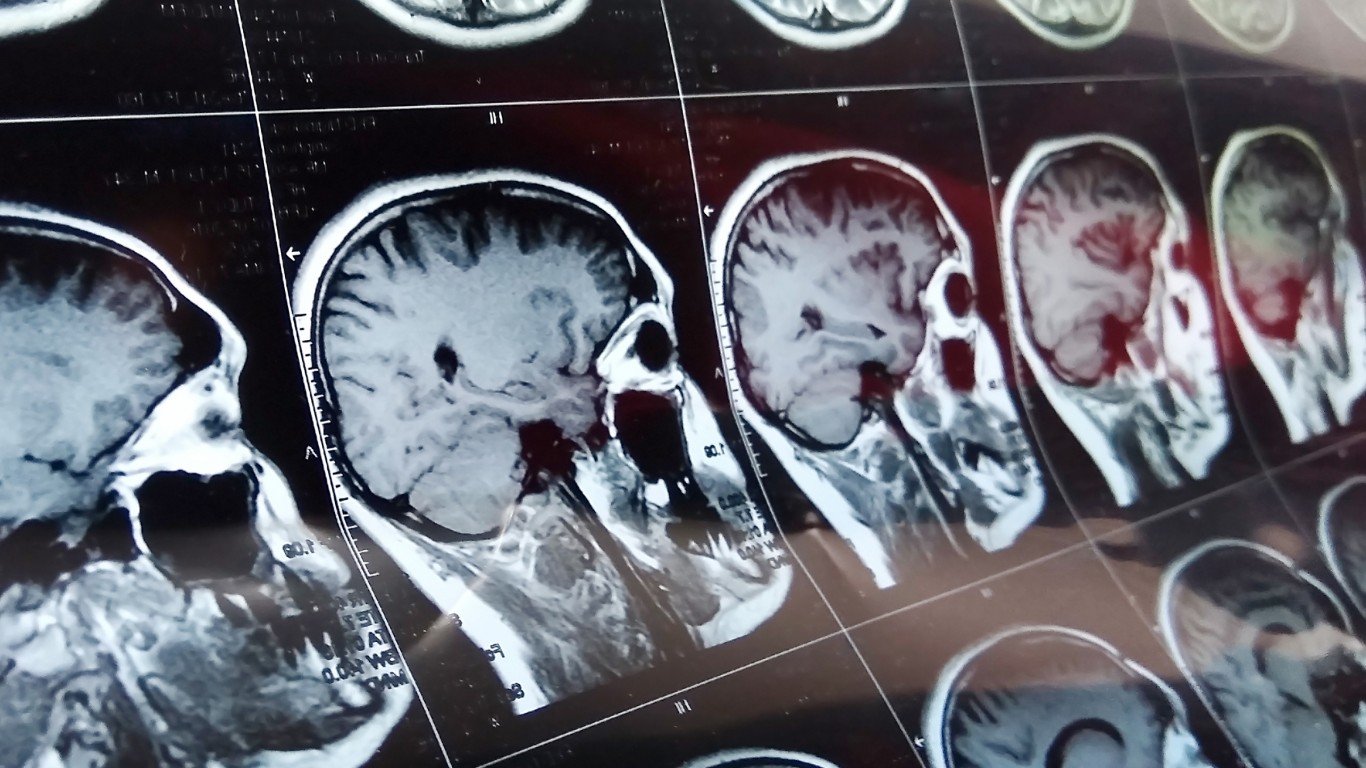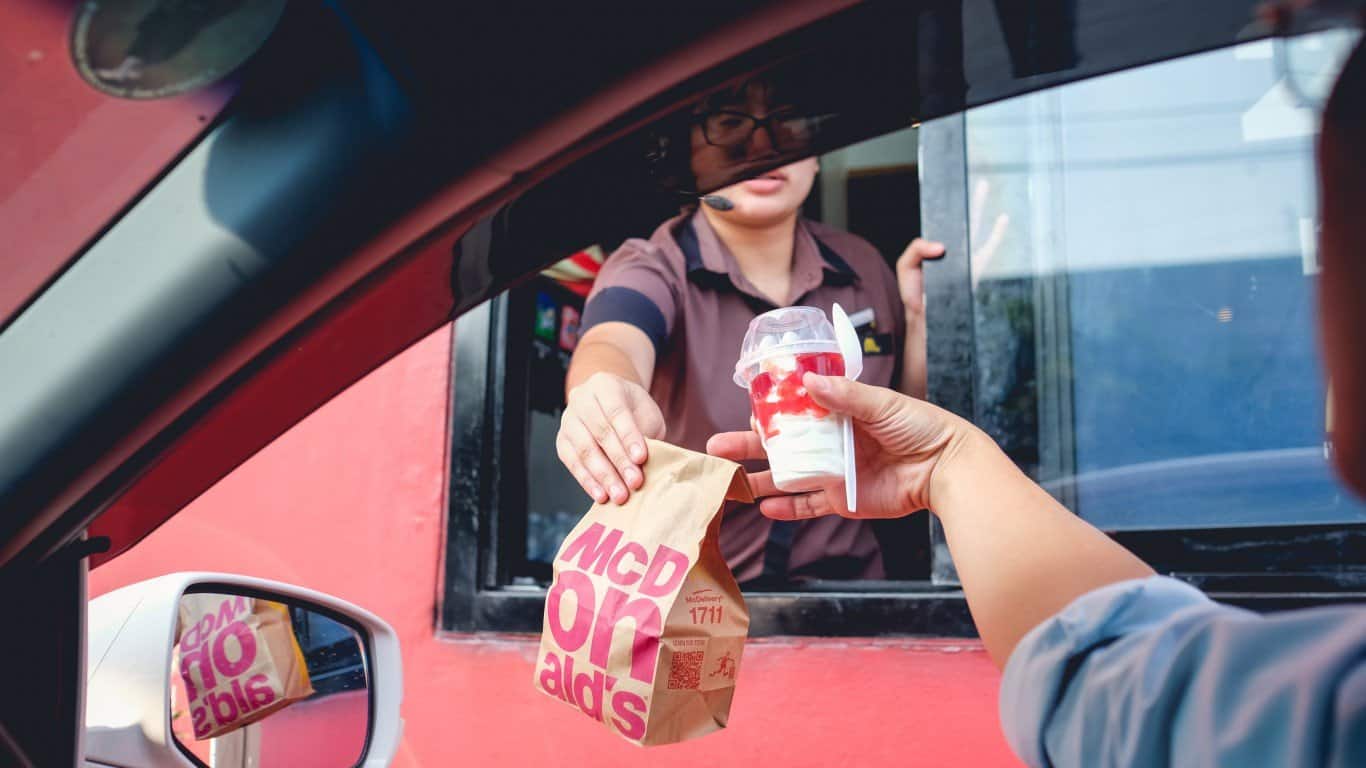Fast food is what its name implies: a priority of quantity and convenience over quality. You can find it on nearly every street corner in America and it’s designed to taste good and eaten quickly. There are, however, more insidious things at play when it comes to the creation of fast food. In this article, we will explore 10 fast food facts that everyone should know. Some of these facts are unsurprising. Others, however, are truly shocking.
To compile a list of the fast food facts everyone should know, 24/7 Tempo consulted a plethora of food, lifestyle, and scientific sources including The International Journal of Food Microbiology and The National Library of Medicine. (For other frightening foods, discover 25 foods that can make you sick or even kill you.)
Soda Machines Contain Fecal Matter

One of the biggest fast food facts everyone should know concerns the type of bacteria often found in fast food soda machines. According to a study published by the International Journal of Food Microbiology, 48% of fast-food restaurant soda machines contain Coliform bacteria. This bacteria is most commonly found in fecal matter.
If you’ve ever worked in a restaurant, you would know how rarely the soda dispensers are cleaned. To be fair, Coliform bacteria in small doses won’t make you sick. However, the study mentioned above also found that 11% of fast food soda machines contained E. coli bacteria. This germ can undoubtedly make you sick, and in rare cases, even cause death.
Breakfast Sandwiches Have the Same Ingredients as Soap
If you’re thinking about hitting the drive-thru before work for breakfast, perhaps you should reconsider. That’s because many of the fast-food breakfast sandwich options are not made with just eggs, but also often contain something called “premium egg blend.” This blend features a chemical called glycerine, which is also found in soaps and shaving creams.
To cut costs, many fast food establishments have turned to this premium egg blend to round out their breakfast sandwiches. While low levels of glycerin shouldn’t affect your health, one wonders what other kinds of strange ingredients are shoved into fast food meals to save a buck.
“Healthy Options” are Not Healthy At All

Say what you will about fast food, but often their marketing is very good. So good that they have convinced the public that the healthy options they offer in place of meals with more ill repute are healthy. Nothing could be further from the truth, however, as many of the fast-food salad options are worse for your health than the hamburgers.
Indeed, one just has to look at the numbers to see the glaring difference. A Big Mac at McDonald’s contains 30 grams of total fat, 10 grams of saturated fat, and 1000 mg of sodium. A Caesar Salad from the same establishment including dressing, however, can reach up to twice as many calories with 18 grams of fat. So you may think a salad option might be healthy, but really, they are often worse for you than the fried foods nearby on the same menu. (For other surprisingly unhealthy meals, explore popular fast food meals that are real calorie bombs.)
Burgers Often Contain Meat from 100 Different Cows

Unlike a steak from a nice restaurant, the beef in hamburgers has more dubious origins. While you may already know how unhealthy a fast food burger can be, you might reconsider learning its origins. That’s what a Washington Post reporter named Roberto A. Ferdman found out when he investigated.
According to his research, a single beef patty can contain traces of over 100 different cows. Since the average herd contains 43.5 cows, that means one burger requires over 2 full cow herds to be made. Since the fast food industry favors quantity over quality, they emulsify various bits of cow into a slurry. That blend is then re-formed in the shape of patties. While the ethics of this type of consumption remains to be seen, it sure doesn’t inspire confidence to know how many cows it takes to get one fast food meal.
Some Burgers Never Go Bad
Perishable food is so named because, well, it perishes after a certain time. It’s evident by the growing mold or the noxious smell from the food rotting. This can be a good thing, however, as it’s natural for food to look and smell bad once it expires. That’s not the case for many fast foods, however, like the McDonald’s hamburger.
Take this hamburger displayed by a Chiropractor in Nebraska, which has remained virtually unchanged for 14 years. While food experts say this is due to the lack of water in the beef patty, it begs the question. Should something that contains so few natural ingredients be consumed at all?
Fast Food Can Shrink the Brain

Another fast food fact everyone should know is that it can spell trouble for your cranium. While everyone knows how unhealthy fast food can be, especially when eaten regularly, less know about how bad the food is your brain. According to a study by JAMA Neurology, there is a link between regular fast food consumption and cognitive decline.
This mostly has to do with the trans fats rife in fast foods. Trans fats can lead to worse attention, memory, and language processing skills. What’s more, the study found that people who ate the most fast food had higher rates of cognitive decline. A fast-food-rich diet also was linked to chronic diseases like heart disease and diabetes. No matter how you slice the fries, they aren’t good for your body or brain.
Chicken Nuggets Have Almost No Meat

Another fast food fact everyone should know is that many fast food chicken nuggets contain almost no meat. Thanks in large part to food documentaries, many are aware that McDonald’s nuggets are made with a blended pink goo of chicken. Less known, however, is how little actual chicken meat is found in said goo.
According to a study published by the American Journal of Medicine, striated muscle or chicken meat was not the predominant ingredient in chicken nuggets. The nuggets contained every other part of a chicken in larger amounts instead. This includes ingredients like fat, as well as bone, nerve, and connective tissue.
Milkshakes Contain Dozens of Ingredients

One surprising fast food fact everyone should know is that most milkshakes contain more ingredients than you can count on two hands. While a homemade milkshake shouldn’t take more than a couple of basic ingredients to build to fruition, fast food milkshakes contain so many chemicals it will make your head spin.
According to an investigative article by The Guardian newspaper, the average strawberry milkshake from your local fast food establishment contains up to 100 chemicals. Besides things like cellulose gum and high-fructose corn syrup, it’s the strawberry flavoring itself that’s the biggest culprit. The Guardian found that artificial strawberry flavoring contains over 50 different chemicals just on its own.
Spicy Fast Food Items Often Contain Sand

Another little-known fast food fact everyone should know is what is often found in spicy items. Fast food items on the spicier side, like chili or buffalo wings, often contain silicon dioxide. Considering all the weird chemicals found in fast food, at first glance, this one seems harmless. You may know this chemical by its more common name, however, which is sand.
Indeed, silicon dioxide is a formidable anti-caking agent. That’s why fast-food companies use it to prevent clumping in heavy meat dishes. Silicon dioxide, besides being sand, is also used in more industrial capacities such as cement, ceramics, and glass-making. While a study by the National Library of Medicine found silicon dioxide is rarely toxic, it does seem to accumulate in certain body tissues.
Beaver Anal Gland Secretions for Added Sweetness

Another fast food fact everyone should know concerns the particular origins of sweeteners used in fast food meals. Indeed, what is making your soda or milkshake that much sweeter might come from the anal gland secretions of beavers. Somehow, scientists found that this secretion called castoreum helps make sweet things that much sweeter.
Though the U.S. Food and Drug Administration considers castoreum to be generally safe, food companies still disguise its origins with terms like “birch tar,” “Russian leather,” or the more vague “natural flavoring.” While castoreum is non-toxic and tastes kind of like vanilla, it also comes from a beaver’s butt, meaning it often mixes with urine and other anal secretions. It’s something to keep in mind the next time you chow down on a fast-food milkshake. (Discover the most popular fast food chain in every state.)
Sponsored: Want to Retire Early? Here’s a Great First Step
Want retirement to come a few years earlier than you’d planned? Or are you ready to retire now, but want an extra set of eyes on your finances?
Now you can speak with up to 3 financial experts in your area for FREE. By simply clicking here you can begin to match with financial professionals who can help you build your plan to retire early. And the best part? The first conversation with them is free.
Click here to match with up to 3 financial pros who would be excited to help you make financial decisions.


